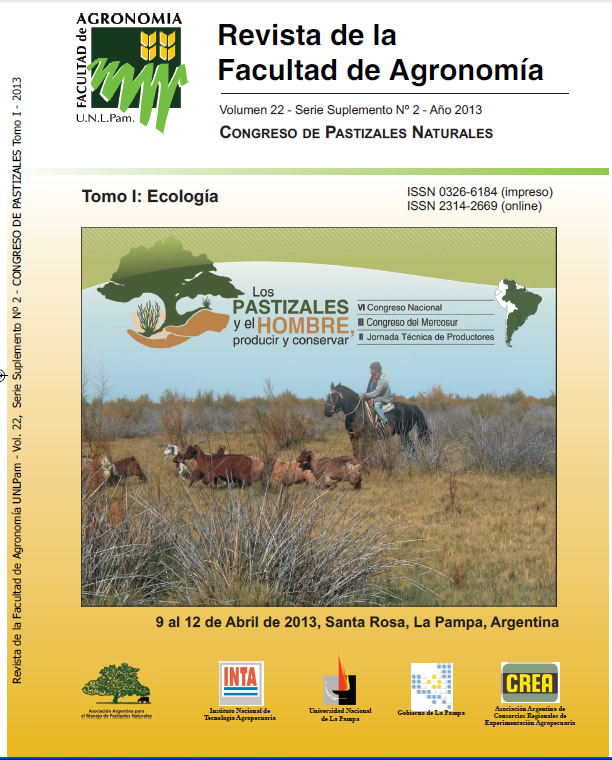Disturbances and their effect in agronomical attributes of shrub thickets in the semiarid Chaco region
Keywords:
Range management, brush management, mechanical treatmentsAbstract
Shrub thickets are a problem for livestock operations in the semiarid Chaco region because of their low current stocking rate and high hindrance for grazing and personnel movement. We assessed the effect of the following disturbances: roller chopping, aerator, ‘rome’ type disc plow; prescribed fire and pasture resting on standing herbaceous biomass (BIO, kg DM ha-1), shrub density (DEN, plants.ha-1) and individual plant volume (VOL, m3.plant) in southwestern Santiago del Estero from 2008 to 2011 using a block design. Treatment effect had no significant effect on BIO, although resting per se increased BIO 200% and the treatments 20-30% above that threshold. Treatments did not influence DEN but VOL significantly (p > F = 0,0001): the aerator plow showed the smaller plant VOL, but its mean DEN was the highest among treatments. In the short term, the aerator plow increased accessibility for grazing, but in the long term its effect could be negative.
Downloads
References
Alessandria E., U. Karlin, J. Casermeiro & R. Ferreyra. 1987. Repuesta de algunos caracteres estructurales de la vegetación resultante de un rolado ante diferentes presiones de pastoreo. Memoria 1eras Jornadas Nacionales de Zonas áridas y Semiáridas. pp. 339-341.
Asner G., A. Elmore, L. Olander, R. Martin & A. Thomas Harris. 2004. Grazing systems, ecosystem responses and global change. Annu. Rev. Env. Resour. 29: 261-99.
Blanco L., E. Orionte, C. Ferrando, P. Namur, F. Biurrun D. Recalde & G. Berone. 2005. Vegetation responses to roller-chopping and buffelgrass seeding in Argentina. Rangeland Ecol. Manag. 58: 219-224.
Boletta P. 1988. Clima. En: Desmonte y habilitación de tierras en la Región Chaqueña semiárida. (R. Casas, Ed.) Red de Cooperación Técnica en el uso de los Recursos Naturales en la Región Chaqueña Semiárida, FAO. Santiago, Chile. pp. 7-21.
Bravo S. 2008. Caracteres estructurales de leñosas que influencian la producción de rebrotes frente tratamientos mecánicos. En: Rolado Selectivo de Baja Intensidad. (C. Kunst, R. Ledesma, M. Navall Eds.). INTA EEA Santiago del Estero. pp. 35- 37.
Cochrane M. & K. Ryan. 2009. Fire and fire ecology: concepts and principles. En: Tropical Fire Ecology (M. Cochrane ed.). Springer-Praxis. pp. 25-62.
Galera M. 1990. Dinámica y manejo de bosques xerofíticos del chaco árido y comunidades sustitutivas post- ala, rolado, con pastoreo en el Noroeste de la Provincia de Córdoba. Argentina. Memoria Taller interregional África/América Latina. MAB. Unesco. Chile.
Gifford R. & M. Howden. 2001. Vegetation thickening in an ecological perspective: significance to national greenhouse gas inventories. Env. Sci.Pol. 4: 59-72.
Guevara J., J. Cavagnaro, O. Estevez, H. Le Houerou & C. Stasi. 1997. Productivity, management and development problems in the arid rangelands of the central Mendoza plains (Argentina). J. Arid Environ. 35: 575-600.
Krebs C. 1999. Ecological methodology. Addison Wesley Longman, Inc. pp. 620.
Kunst C., R. Ledesma, S. Bravo, A. Albanes,i A. Anriquez, H. van Meer & J. Godoy. 2012. Disrupting woody steady states in the Chaco region (Argentina): Responses to combined disturbance treatments. Ecol. Eng. 42: 42-53.
McIver J. & L. Starr. 2001. Restoration of degraded lands in the interior Columbia River basin: passive vs. active approaches. Forest Ecol. Manag. 153: 15-28.
Passera C., Allegretti L. & O. Borsetto.
a. Repuesta de la vegetación excluida al pastoreo en una comunidad de Larrea cuneifolia del piedemonte mendocino. Multequina 5: 25-31.
Passera C., Borsetto, O. & L. Allegreti. 1996b. Short term effects of shrub control on two different plant communities in Argentina. J. Arid Environ. 34: 415-420.
Platt W. & J. Connell. 2003. Natural disturbances and directional replacement of species. Ecol. Monogr. 73: 507-522.
Roberts M. 2007. A conceptual model to characterize disturbance severity in forest harvests. Forest Ecol. Manag. 242: 58-64.
Statistical Analysis Systems. 2002. SAS. Version 8. pp. 500.
Sousa. W. 1984. The role of disturbance in natural communities. Annu. Rev. Ecol. Syst. 15: 353-391.
Trollope W. & N. Tainton. 1986. Effect of fire intensity on the grass and bush components of the Eastern Cape. J. Grasslands Soc. sth Afr. 3: 37-42.
Downloads
Published
Issue
Section
License
La Editorial de la Universidad Nacional de La Pampa (EdUNLPam) exigirá a los/as autores/as la firma del siguiente documento:
La EdUNLPam lleva a cabo la publicación del artículo: (Título del Artículo) en SEMIÁRIDA Rev.Fac.Agron UNLPam ISSN 2362-4337 (impresa) ISSN 2408-4077 (en línea), del cual el/los abajo firmantes son autores de una o más partes. En el mismo acto, el/los autores entregan exclusivamente a la EdUNLPam todos sus derechos protegidos por las leyes de propiedad intelectual que rigen en la Argentina para reproducir, publicar, editar, fijar, comunicar y transmitir públicamente en cualquier formato o medio impreso o electrónico, inclusive internet, el artículo enviado a publicación e incluirlo en índices o bases de datos nacionales e internacionales. A cambio, la EdUNLPam entrega a los autores la autorización para la publicación o reimpresión con ines académicos y educativos en cualquier libro o medio de divulgación, con la sola obligación de citar el artículo original publicado en la EdUNLPam. Cada autor acuerda en que el material provisto a la EdUNLPam es un trabajo original, que no ha sido impreso o publicado en cualquier otro medio con anterioridad y que no vulnera derechos de terceros. El Primer autor tendrá la posibilidad de leer y corregir el artículo ya editado como “prueba de galera”, pero si el autor no devolviera esas correcciones de la prueba de galera dentro del tiempo especificado, el proceso de producción y publicación podrá proseguir sin la aprobación del autor. El/los autor/es no recibirán compensación monetaria de la EdUNLPam por el uso del material contenido en este artículo y asumen la responsabilidad de las opiniones vertidas en él.






.png)



22.png)



.jpg)




.jpg)
